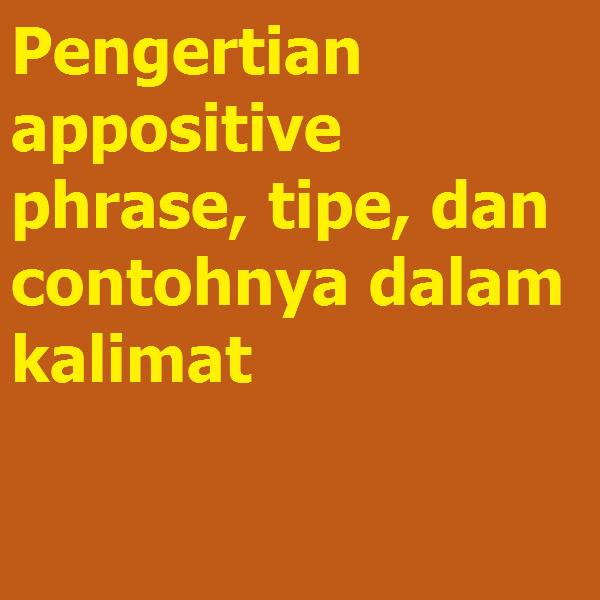
Apa yang dimaksud dengan appositive phrase dan bagaimana contoh penggunaannya dalam kalimat bahasa Inggris?
Appositive adalah kata benda atau frase kata benda (appositive phrase) yang memberi nama lain untuk kata benda tepat di sebelahnya. Ini menambahkan kata-kata deskriptif tentang hal tertentu (kata benda), yang membantu membuat kalimat lebih rinci; atau, menambahkan informasi penting untuk membuat makna kalimatnya jelas.
Contoh Appositive Phrase
Appositive noun atau Apposite phrases dapat muncul sebelum atau sesudah kata benda utama. Bisa di awal, tengah, atau akhir kalimat, asalkan tepat di sebelah kata benda yang dideskripsikan.
Simak contoh kalimat di bawah ini:
- The smallest state in the US, Rhode Island is in the northeast.
- The dog, a beagle, is great at following a scent.
- The apartment had bugs, big brown cockroaches!
As you can see, the appositives add information about the nouns. For instance, “a beagle” describes the type of dog, while “a cockroach” describes the bug in the cereal.
Types of Appositive Phrases
Apposite phrases follow two forms: a noun followed by the apposite phrase, or appositive phrase followed by a noun. You can identify an appositive phrase because it is what adds details to the main noun, so, depending on the sentence’s style, sometimes it comes before, and sometimes it comes after.
a. A noun followed by an Appositive
Cara paling umum untuk menggunakan appositive phrase adalah dengan meletakkannya setelah kata benda, seperti berikut ini:
- Sparky, the dog who loved popcorn, was well known around the neighborhood.
- The dog, who loved popcorn, could often be spotted at the fair.
- The dog named Sparky was loved by everyone.
- At the fair, we saw Sparky, the friendly neighborhood dog.
Meskipun mungkin menambah informasi penting, appositive phrase seharusnya tidak mempengaruhi tata bahasa kalimat. Jadi, kalimat harus masuk akal tanpa itu:
- Sparky was well known around the neighborhood.
You can see that though the sentence is less detailed, it is still grammatically correct!
b. Appositive followed by a Noun
Meskipun tidak umum seperti contoh di atas, terkadang appositive phrases datang sebelum kata benda, seperti ini:
- Named Sparky, the dog was well known around the neighborhood.
- A lover of popcorn, Sparky was often spotted at the fair.
- The neighborhood’s favorite dog, Sparky was friendly to everyone.
Di sini, appositive phrase menggambarkan kata benda yang mengikutinya. Sekali lagi, jika kalian menghapus kalimat yang tepat, kalimatnya masih masuk akal, seperti ini:
- The dog was well known around the neighborhood.
How to Avoid Mistakes
Appositive phrases are easy to spot and pretty simple to use. But, there are still common mistakes! Here are some things to remember:
- An appositive phrase is always right next to the noun it describes.
- Appositive phrases can come at the beginning, middle, or end of a sentence.
- Most times an appositive phrase comes after its noun, but sometimes it comes before.
- An appositive phrase does not have a subject and predicate, therefore, it is not a complete sentence.
Terlebih lagi, ketika menggunakan appositive phrase, orang terkadang melakukan kesalahan dengan koma mereka. Terkadang koma mutlak diperlukan, sementara terkadang kalian tidak membutuhkannya sama sekali.
Jika appositive phrase memberikan informasi penting untuk sebuah kalimat, maka tidak perlu membuat koma. Seperti ini:
- The former First Lady Barbara Bush could become the oldest living First Lady.
Without the appositive, this sentence would be “The former First Lady could become the oldest living First Lady”—we wouldn’t know who the First Lady was. Since “Barbara Bush” is necessary information, we don’t need commas.
Jika appositive phrase tidak penting dalam sebuah kalimat, maka kalian perlu koma (s). Seringkali appositive phrase adalah di dalam dua koma, seperti ini:
- Barbara Bush, the former First Lady, could become the oldest living First Lady.
Here, the appositive phrase is “former First Lady,” because it adds information about Barbara Bush. In this situation, it doesn’t give essential information. We could take away the appositive phrase, and it still makes sense:
- Barbara Bush could become the oldest living First Lady.
Demikian penjelasan tentang appositive phrase.
thanks